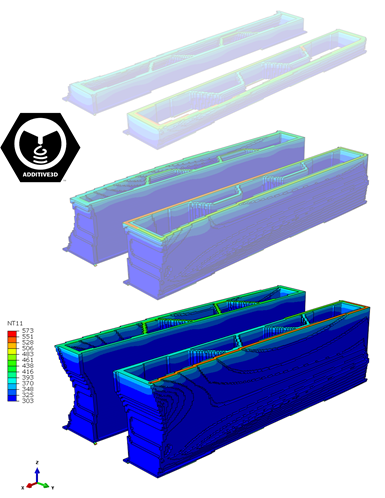A collaboration between Thermwood Corp. (Dale, Ind., U.S.), the LSAM Research Laboratory at Purdue University (Lafayette, Ind., U.S.), the University of Sheffield (U.K.) and the University of Oxford (U.K.) is targeting the advancement of tidal energy manufacturing through the joint development and demonstration of a double-sided large-scale additively manufactured (LSAM) mold for producing 2-meter-long tidal turbine blades.
Initiated at JEC World 2025, the project is now actively progressing toward transforming how large-scale tooling is designed and manufactured for tidal energy.
Purdue University’s Additive3D simulation platform was used to predict and optimize the printing process for the double-sided mold, which is made of carbon fiber-reinforced polycarbonate (PC). The physics-based virtual twin models temperature evolution, postprocessing effects and mold performance — including heat treatment, material removal and anisotropic shape compensation. Additive3D’s predictive capability ultimately provides confidence in LSAM projects, enabling precise control of tooling for high-performance composite production.
Following printing, Sheffield’s Advanced Manufacturing Research Centre (AMRC) performed precision machining to incorporate sensor placements, blade root locator mounts and resin inlet/outlet features.
The completed two-sided mold tool supports single-shot infusion of carbon fiber reinforcement around a central blade core structure, enabling fabrication of a blade with optimal structural efficiency and reduced manufacturing time.
At JEC 2025, Thermwood’s LSAM 510 3D printed both sides of this carbon fiber-reinforced polycarbonate (PC) mold live on-site.
Mold development was followed by the development of the 2-meter tidal turbine blade, which features a hybrid configuration: A stainless steel root transitioning into a polycarbonate core with a carbon fiber-reinforced polymer (CFRP) skin. This design provides mechanical integrity at the root while minimizing weight and maximizing efficiency along the blade span.
Embedded sensors — including fiber optic sensing, strain gauges, thermocouples and accelerometers — will deliver real-time structural monitoring, offering critical insight into manufacturing quality, operational performance and structural health.
Next, the blade will undergo fatigue testing at the University of Edinburgh’s FastBlade facility, followed by extended sea trials with a scaled turbine system. These trials will generate valuable data on durability, structural performance and environmental loading.







 Lu public network security: 37140202000173
Lu public network security: 37140202000173



